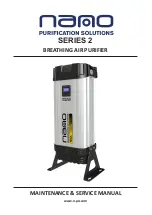
13
EG
USING THE 1-HOUR OFF
TIMER
1. 1-Hour OFF Timer
This function causes the unit to operate for one hour and
then stop, regardless of whether the unit is on or off when
this button is pressed.
The
indicator in the display indicates that this function is
operating.
Setting procedure:
Regardless of whether the unit is operating or stopped, press the
1 HR. TIMER button.
appears in the display.
Cancellation procedure:
Press the ON/OFF operation button to turn the unit off, wait for the
unit to stop operating, and then press the ON/OFF operation
button again.
The 1-Hour Timer function is now cancelled and the unit operates
normally.
• If, while the 1-Hour Timer function is operating, the 1HR. TIMER
button is pressed once to cancel the function and then again, the
unit continues to operate for one hour from that point in time and
then stops.
• It is not possible to use the OFF Timer and 1-Hour OFF Timer
together. Whichever function is set last takes precedence. If the
1 HR. TIMER button is pressed while the TIMER OFF function
operates, the OFF Timer is cancelled and the unit will stop
operating one hour later.
2. Operation together with the daily ON/OFF
repeat timer
The 1-Hour OFF Timer setting is given priority over the DAILY ON/
OFF REPEAT setting.
TIPS FOR ENERGY SAVING
Do not
• Block the air intake and outlet of the unit. If they are
obstructed, the unit will not work well, and may be
damaged.
• Let direct sunlight into the room. Use sunshades, blinds or
curtains. If the walls and ceiling of the room are warmed by the
sun, it will take longer to cool the room.
Do
• Always try to keep the air filter clean. (Refer to “CARE AND
CLEANING”.) A clogged filter will impair the performance of the
unit.
• To prevent conditioned air from escaping, keep windows, doors
and any other openings closed.
ADJUSTING THE AIRFLOW
DIRECTION
1. Horizontal
The horizontal airflow can be adjusted by moving the vertical
vanes with your hands to the left or right.
When the humidity is high, the vertical vanes should be in the
front position during the cooling or dehumidifying operation.
If the vertical vanes are positioned all of the way to the right
or left, condensation may begin to form around the air vent
and drip down.
2. Vertical
The vertical airflow can be adjusted by moving the flap with the
remote control unit. Do not move the flap with your hands. Confirm
that the remote control unit has been turned on. Use the FLAP
button to set either the sweep function or one of the six airflow
direction settings.
• The flap automatically closes when the unit is off.
• During the heating operation, the fan speed will be very low and
the flap will be in the horizontal position (position
) until the air
being blown out of the unit begins to warm. Once the air warms
up, the flap position and fan speed change to the settings
specified with the remote control.
• Use the FLAP button on the remote control to adjust the
position of the flap. If you move the flap by hand, the flap
position according to the remote control and the actual flap
position may no longer match. If this should happen, shut
off the unit, wait for the flap to close, and then turn on the
unit again; the flap position will now be normal again.
• Do not have the flap pointed down during cooling
operation. Condensation may begin to form around the air
vent and drip down.
NOTE
CAUTION
HEAT
SWEEP
SWEEP
A. Sweep function
The flap starts moving
up and down to deliver
air over the sweep
range.
B. Setting the airflow manually
Referring to the above
illustration, use the
FLAP button to set the
airflow direction within
the range used during
the heating, cooling, or
dehumidifying
operation.
C. Auto flap function
The flap is set
to the
recommended
position.
COOL
DRY
FAN
NOTE
CAUTION
OI-925-13-EG
01_SAP-KRV96EHDS_EN.fm Page 13 Wednesday, January 17, 2007 9:51 AM




































